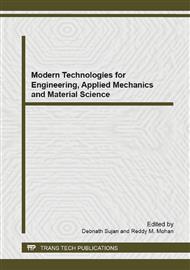[1]
William F. Smith, Foundations of materials science and engineering, McGraw-Hill, Third edition, 1990, pp.494-497.
Google Scholar
[2]
Raymond A. Higgins, Material for the engineering technician, The English university press ltd, First published 1972, p.161.
Google Scholar
[3]
J. L, Pandey, S. Inder and, M. N. Singh. Electrochemical corrosion behaviour of heat treated AISI 304 austenitic stainless steel in inorganic acid mixture. Anti –Corrosion Methods and Materials 1997, Vol. 44, No1, p.6.
DOI: 10.1108/00035599710157413
Google Scholar
[4]
M. Matula, L. Hyspecka, M. Svoboda, V. Vodarek, C. Dagbert, J. Galland, Z. Stonawska, and L. Tuma. Intergranular corrosion of AISI 316L steel. Materials Characterization 2001, Vol. 46, p.203 – 210.
DOI: 10.1016/s1044-5803(01)00125-5
Google Scholar
[5]
Aydogdu, G. H. and Aydinol, M. K. (2006) Determination of susceptibility to intergranular corrosion and electrochemical reactivation behaviour of AISI 316L type stainless steel. Corrosion Science Vol. 48, p.3565 – 3583.
DOI: 10.1016/j.corsci.2006.01.003
Google Scholar
[6]
L.W., Tsay, S.C., Yu, S. D. Chyou and D.Y. Lin. A comparison of hydrogen embrittlement susceptibility of two austenitic stainless steel welds. Corrosion Science 2007, Vol. 49, p.4028 – 4039.
DOI: 10.1016/j.corsci.2007.04.005
Google Scholar
[7]
M. Matula, C. Dagbert, L. Hyspecka, J. Galland and I. Martinakova. Detection of sensitization to intergranular corrosion in AISI 316Lstainless steel: electrochemical potentiokinetic reactivation tests. ProcInt Conf Euro–corr, 2000, London.
DOI: 10.1016/s1044-5803(01)00125-5
Google Scholar
[8]
I. Betova, M. Bojinov, P. Kinnunen, P. Pohjanne and T. Saario Influence of the electrolyte composition and temperature on the transpassive dissolution of austenitic stainless steels in simulated bleaching solutions. ElectrochimicaActa2002 Vol. 47, p.3335.
DOI: 10.1016/s0013-4686(02)00271-2
Google Scholar
[9]
A. Galal, N. F. Atta and M. H. S. Al–Hassan. Effect of some thiophenederivatives on the electrochemical behaviour of AISI 316 austenitic stainless steel in acidic solutions containing chloride ions. I Molecularstructure and inhibition efficiency relationship. Materials Chemistry and Physics 2005, Vol. 89, p.38.
DOI: 10.1016/j.matchemphys.2004.08.019
Google Scholar
[10]
S. Girija, U. Kamachi Mudali, H.S. Khatak and B. Raj. The application of electrochemical noise resistance to evaluate the corrosion resistance of AISI type 304 SS in nitric acid. Corrosion Science 2007, Vol. 49, p.4051– 4068.
DOI: 10.1016/j.corsci.2007.04.007
Google Scholar
[11]
S. Frangini and S. Loreti. The role of alkaline-earth additives on the molten carbonate corrosion of 316L stainless steel. Corrosion Science2007, Vol. 49, p.3969 – 3987.
DOI: 10.1016/j.corsci.2007.05.005
Google Scholar
[12]
A. Rajan Heat treatment principles and techniques. Prentice Hall of India, New Delhi. 1998, pp.1-6.
Google Scholar
[13]
ASTM A 262 – 90. Standard practices for detecting susceptibility to intergranular attack in austenitic stainless steels. Annual Book of ASTM Standards 1990: Section 3. Metals test methods and analytical procedures: Vol. 03. 02. Wear and erosion. Metal corrosion. Philadelpia, PA: ASTM, (1992).
DOI: 10.1520/a0262-02ar08
Google Scholar
[14]
K. P. Balan, , A. Venugopal Reddy and D. S. Sarma. Austenite precipitation during tempering in 16Cr – 2Ni martensitic stainless steels. ScriptaMaterialia1998, Vol. 39, No 7, p.901 – 905.
DOI: 10.1016/s1359-6462(98)00267-x
Google Scholar
[15]
L. C. Lim, M. O. Lai, and J. Ma, Tempering of AISI 403 stainless steel. Materials Science and Engineering 1993, Vol. A171, p.13 – 19.
DOI: 10.1016/0921-5093(93)90388-u
Google Scholar
[16]
B. Qin, Z. Y. Wang, and Q. S. Sun. Effect of tempering temperature on properties of 00Cr16Ni5Mo Stainless steel. Materials Characterization. 2007, Article in press.
DOI: 10.1016/j.matchar.2007.08.025
Google Scholar
[17]
Husain Baker, Corrosion engineering and metal surface protection, Baghdad, 1989, p.81.
Google Scholar
[18]
G.O. Ilevbare, and G.T. Burstein. The role of alloyed molybdenum in the inhibition of pitting corrosion in stainless steels. Corrosion Science2001, Vol. 43, pp.485-513.
DOI: 10.1016/s0010-938x(00)00086-x
Google Scholar


